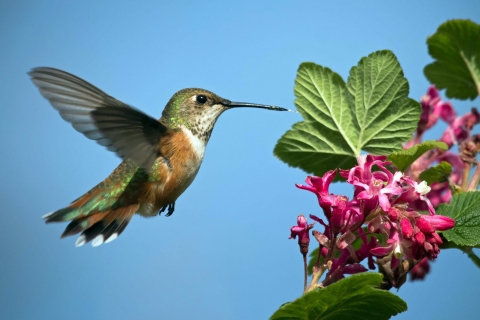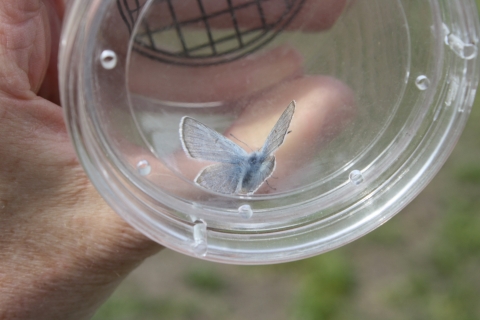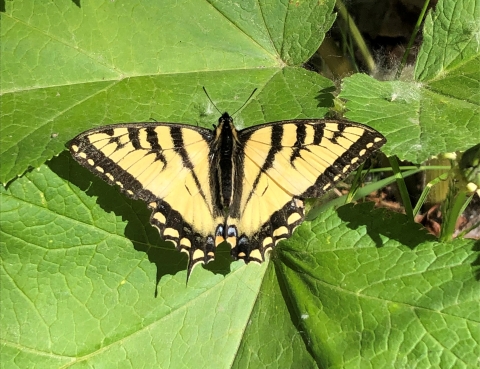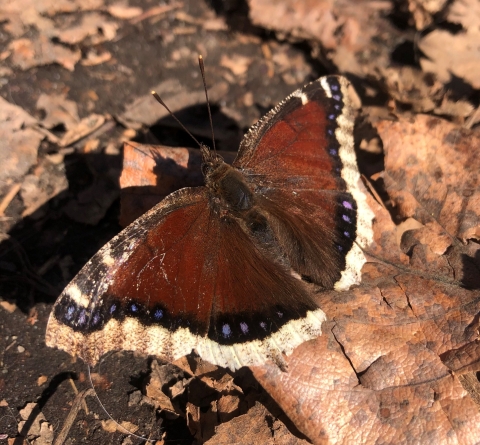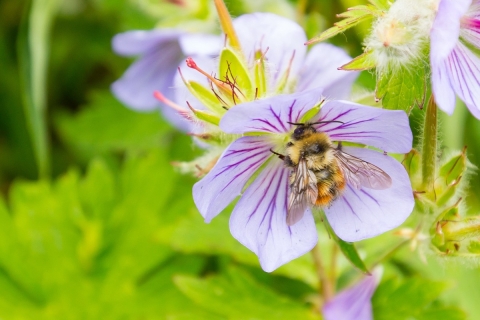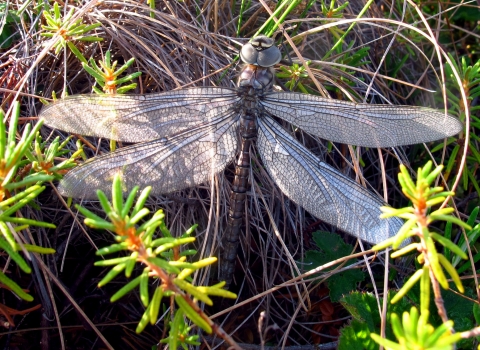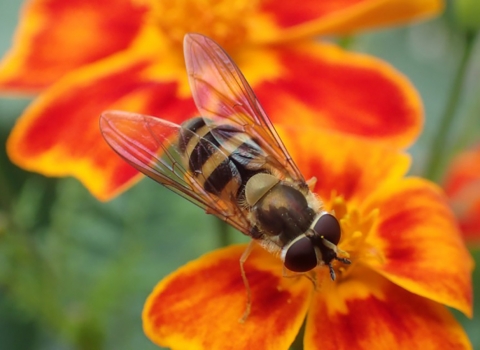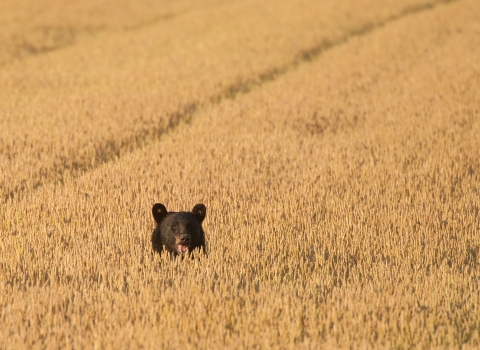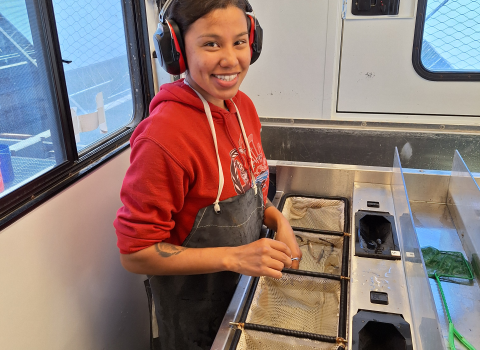A crispness has snuck into the air. Vibrant colors are creeping into the vegetation. Some of us have seen the first snow of the year. Flowers have gone to seed, bringing abundant berries to harvest. Let us thank the pollinators… but where are they now? And, how can you help them?
What happens to Alaska’s pollinators in the winter?
Pollinators (the creatures that carry pollen from flower to flower, allowing plants to reproduce) come in all shapes and sizes. They use many different strategies to survive Alaska’s cold, harsh winters.
HUMMINGBIRDS
Some pollinators just aren’t built to survive Alaska’s winter…so they get out of town. Fast.
Each year, rufous hummingbirdsleave the state at the end of peak flower season. The males leave first, heading south on the Rocky Mountain flyway where alpine flowers are still in bloom. Females and juvenile hummingbirds follow soon after.
Not all pollinators are capable of leaving the state. Some tough it out all winter long.
BUTTERFLIES
Did you know Alaska’s various butterfly species overwinter in all the different phases of their lifecycle? A quick refresher: butterflies grow from an egg, into a larva (caterpillar), a chrysalis (hard-shelled pupa), and finally to a 4-winged fluttery butterfly.
The small, charismatic Alaskan blue (Plebejus idas alaskensis) winters as an egg on a variety of plants such as Labrador tea and lupine. When the weather warms in the spring, it undergoes the metamorphosis to become a butterfly. Though guidebooks describe the Alaskan blue as “not a particularly strong flier”, it is widespread across the state.
Fritillary species (Boloria spp.) are found across Alaska and share the common trait of hibernating as larvae. Some are known to use flower species such as violets and dryas as winter hosts, while others use willows.
Canadian tiger swallowtails (Papilio canadensis) inhabit the boreal forest and spend the long winter months as chrysalises in trees including aspen, ash, and willow.
Mourning cloaks (Nymphalis antiopa) survive winter as adult butterflies nestled in willows across much of the state. They are some of the earliest butterflies seen each year, ready to fly in the warm spring sun.
BEES
Alaska's bees use different strategies to survive the winter months.
Bumble bees (Bombus spp.) are social bees native to North America with a similar life-history to the European honeybee. Queens lay eggs and establish colonies in spring, often in abandoned rodent burrows.
The worker bees of these colonies forage on the pollen and nectar of Alaska’s diverse summer flowers. As summer wanes, male drones and a new generation of queens are born. These queens mate as summer fades to fall and eat to build up their nutrient reserves for the long, solo winter ahead.
Bumble bee queens are the only colony members to survive through the long Alaskan winter. In the fall, they find locations to burrow into the ground and enter a deep hibernation. This is the part of the bee’s life cycle that scientists know the least about, but the survival of these overwintering queens is essential for the success of future bee populations.
Solitary bees
The vast majority of North America’s bee species are solitary and in Alaska they represent about 80% of the diversity of species. There are many types of solitary bees which means there are various strategies for surviving winter.
Some species of solitary bees, such as Clark’s miner bee (Andrena clarkella), overwinter as adults. This allows them to emerge early in spring to take advantage of Alaska’s short growing season. Other species overwinter in a larval stage and emerge later in the summer after pupating. Solitary bees are generally active for 2–3 weeks and provide food to support only a dozen or so offspring. Female solitary bees defend their nests from intruders and feed offspring by themselves.
Adult bees must select a place to spend the winter. Solitary bees fall into two general nesting categories: ground nesters and cavity nesters. Ground nesting bees burrow into the soil to stay warm in the winter months. Cavity nesters use dead stems, hollow wood, or piles of brush to nest.
FLOWER FLIES
Like butterflies and solitary bees, flower flies (wanna-bees) can overwinter in different life stages. In general, there are two strategies: survive as larvae or as adults.
Hibernating adults find cubby holes in old trees, fallen logs, or piles of rocks. Species that survive winter as adults will be some of the first flies you see each spring. Larvae survive winter by hiding in the soil, preparing for the long-awaited warm season where they will feed, pupate, and emerge as adults.
Alaska’s various pollinators each have specific needs but they all require high-quality habitat to thrive. As you embark on the process of preparing your space for winter, keep pollinators in mind:
- Leave a section of lawn un-mowed to protect nesting pollinators.
- Create a log, rock, and leaf pile in the corner of your neighborhood to create habitat for nesting pollinators.
- Let dead flowers and their seeds stand. Resist the urge to pull plants at the end of the season.
- Build a bee hotel by collecting hollow sticks and plant material and place it in a safe location outside.
- Start thinking about landscaping for pollinators next spring. Could you plant a willow in your yard to support wintering butterflies? Or, commit to a native plant garden to feed all sorts of pollinators.
Thank you to Matthew Carlson at the University of Alaska Anchorage Alaska Center for Conservation Science for his insights. Sabrina and Matt are members of the Alaska Pollinator Coordination Group which aims to address pollinator conservation needs across the state.
In Alaska we are shared stewards of world renowned natural resources and our nation’s last true wild places. Our hope is that each generation has the opportunity to live with, live from, discover and enjoy the wildness of this awe-inspiring land and the people who love and depend on it.


